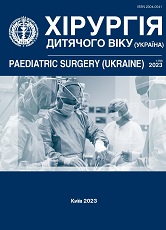Infusion and transfusion therapy for victims with penetrating head wounds in preparation for aeromedical evacuation
DOI:
https://doi.org/10.15574/PS.2023.78.25Keywords:
hemorrhagic shock, traumatic brain injury, shock index, aeromedical evacuationAbstract
Purpose - to assess the effectiveness and scope of infusion and transfusion therapy for wounded with penetrating head wounds at the stage of stabilization and preparation for aeromedical evacuation.
Materials and methods. A retrospective analysis of the medical records of 122 servicemen who were injured during combat missions was conducted. The Group 1 included 52 servicemen with mine blast thoracoabdominal wounds; the Group 2 - 40 servicemen with penetrating head wounds; the Group 3 - 30 servicemen with combined penetrating head wounds and mine blast thoracoabdominal wounds. The study shows the median and interquartile range of the values of the studied indicators. The Kruskal-Wallis test was used to analyze the data, and a posteriori comparisons were made using the Dunn’s test.
Results. A retrospective analysis of the medical records of 122 servicemen who were injured during combat missions was conducted. The total volume of haemotransfusion in the victims of the Group 1 was 1525 (445-2325) ml, in the Group 2 - 0 (0-0) ml, in the Group 3 - 1150 (0-1800) ml. The volume of infusion therapy at the stabilization stage in the Group 1 was 3150 (2450-4200) ml, in the Group 2 - 1200 (800-1400) ml, in the Group 3 - 1400 (880-3200) ml. In the Group 1, the shock index (SI) decreased to 0.67 (0.61-0.71), in the Group 2 - to 0.58 (0.55-0.66), in the Group 3 - to 0.66 (0.61-0.71). The correlation analysis in the Groups 1 and 3 revealed a negative correlation of medium severity between the amount of haemotransfusion and the change in SI (ρ=-0.353 at p=0.01; ρ=-0.525 at p=0.003).
Conclusions. Infusion and transfusion therapy in the prescribed volumes allowed to reduce the rate of SI in wounded servicemen by 23.7% (95% CI: 19.2-29.5%). Victims of the Group 3 required a greater volume of infusion and transfusion therapy, which affected the time required to prepare for aeromedical evacuation.
The research was carried out in accordance with the principles of the Helsinki Declaration. The study protocol was approved by the Local Ethics Committee of the institution mentioned in the paper. The informed consent of the patient was obtained for conducting the studies.
No conflict of interests was declared by the authors.
References
Cannon JW. (2018). Hemorrhagic shock. New England Journal of Medicine. 378 (4): 370-379. https://doi.org/10.1056/NEJMra1705649; PMid:29365303
Khytryi GP, Ukhach YD. (2022). Assessment of blood loss in injured military personnel with penetrating brain injuries during preparation for aeromedical evacuation. Ukrainian Journal of Military Medicine. 3 (4): 93-99. https://doi.org/10.46847/ujmm.2022.4(3)-093
Leibowitz, A, Brotfain E, Koyfman L, Klein M, Hess S, Zlotnik A et al. (2019). Treatment of combined traumatic brain injury and hemorrhagic shock with fractionated blood products versus fresh whole blood in a rat model. European Journal of Trauma and Emergency Surgery. 45: 263-271. https://doi.org/10.1007/s00068-018-0908-9; PMid:29344708
Mayer AR, Dodd AB, Rannou-Latella JG, Stephenson DD, Dodd RJ, Ling JM, Chaudry IH. (2021). 17α-Ethinyl estradiol-3-sulfate increases survival and hemodynamic functioning in a large animal model of combined traumatic brain injury and hemorrhagic shock: a randomized control trial. Critical Care. 25 (1): 1-13. https://doi.org/10.1186/s13054-021-03844-7; PMid:34915927 PMCid:PMC8675515
Muller CR, Courelli V, Lucas A, Williams AT, Li JB, Dos Santos F et al. (2021). Resuscitation from hemorrhagic shock after traumatic brain injury with polymerized hemoglobin. Scientific reports. 11 (1): 2509. https://doi.org/10.1038/s41598-021-81717-3; PMid:33510204 PMCid:PMC7843604
Stolla M, Zhang F, Meyer MR, Zhang J, Dong JF. (2019). Current state of transfusion in traumatic brain injury and associated coagulopathy. Transfusion. 59 (S2): 1522-1528. https://doi.org/10.1111/trf.15169; PMid:30980753
Zusman BE, Dixon CE, Jha RM, Vagni VA, Henchir JJ, Carlson SW et al. (2021). Choice of whole blood versus lactated Ringer's resuscitation modifies the relationship between blood pressure target and functional outcome after traumatic brain injury plus hemorrhagic shock in mice. Journal of Neurotrauma. 38 (20): 2907-2917. https://doi.org/10.1089/neu.2021.0157; PMid:34269621 PMCid:PMC8672104
Downloads
Published
Issue
Section
License
Copyright (c) 2023 Paediatric Surgery (Ukraine)

This work is licensed under a Creative Commons Attribution-NonCommercial 4.0 International License.
The policy of the Journal “PAEDIATRIC SURGERY. UKRAINE” is compatible with the vast majority of funders' of open access and self-archiving policies. The journal provides immediate open access route being convinced that everyone – not only scientists - can benefit from research results, and publishes articles exclusively under open access distribution, with a Creative Commons Attribution-Noncommercial 4.0 international license(СС BY-NC).
Authors transfer the copyright to the Journal “PAEDIATRIC SURGERY.UKRAINE” when the manuscript is accepted for publication. Authors declare that this manuscript has not been published nor is under simultaneous consideration for publication elsewhere. After publication, the articles become freely available on-line to the public.
Readers have the right to use, distribute, and reproduce articles in any medium, provided the articles and the journal are properly cited.
The use of published materials for commercial purposes is strongly prohibited.

